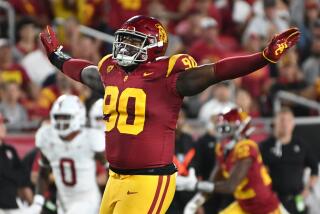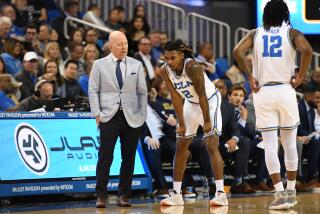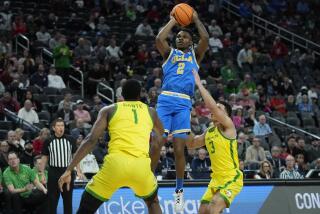Kenny Anderson Is Ahead of His Time
- Share via
It is difficult to think of Kenny Anderson in the present tense. Of course he’s currently an all-American, averaging 26.6 points a game for Georgia Tech.
But it is not just his immediate brilliance that comes to mind when regarding the sophomore point guard.
Anybody who has seen his “how’d he do that?” exploits in sports highlight packages on the nightly news can only ask, What does the future hold for Anderson?
The answers assuredly lie in the NBA. Barring unforeseen circumstances such as a devastating injury (and he has a $2 million insurance policy in that event), Anderson will determine whether he will leave the Yellow Jackets for the professional ranks in June.
“I have friends who play -- Ron Harper, (Jerry) Reynolds, Bernard King, Kenny Smith -- and when it gets to the heat of things, I’ll talk to them all, but I think I’ll be in the top five,” he said, indicating he’s already planning for the move. “I know my talents and I know I have the heart ... it’s about competing and going after something and that’s what I want to do.”
Hearing the words is one thing but looking at the source is another. A slightly built 168 pounds, Anderson just doesn’t look like a college star, let alone a pro basketball player. He looks more like the kid brother you had to drag around to the neighborhood courts.
For Anderson, those courts were in New York City and nobody had to drag him anywhere. As a freshman last season, while teammates and future pros Dennis Scott and Brian Oliver drove around campus in their cars, Anderson rode a bicycle, only enhancing his waif-like image.
In a conversation in Atlanta recently he revealed that he got his first driver’s license last September, and while he’s still reliant on the team managers for rides to and from team functions, there was clearly unmasked joy at the acquisition.
“I was acting just like a little kid,” he said. “ ‘I got it, I got it.’ Hopefully I’ll be able to get a car soon.”
Anderson will undoubtedly soon be in position to buy any automobile he desires. It wouldn’t be surprising if he did just that, having already been forced to act older and wiser than his years in interviews, meetings and travels.
And the closer he gets to the end of the season, the more the scrutiny builds. Each Georgia Tech game is attended by at least three or four NBA scouts. In addition, Yellow Jackets Coach Bobby Cremins, well accustomed to the process, is also quick to invite representatives to his team’s practices.
The day after the 80-65 victory over Maryland on Feb. 1, Billy Cunningham and Stu Inman of the Miami Heat were present at a short workout at Alexander Memorial Coliseum. Cremins made a point of bringing over Anderson before the workout to meet them.
Soon all three were shooting the breeze, with nervous laughter abounding. Cunningham and Inman were eager to establish themselves in the player’s mind; Anderson did his part in a routine he’s performed countless times.
“Me and all (my) coaches have had a lot of talks about that. Growing up as a big name in the lights, they’ve always said, ‘Watch what you say, people are watching you,’ ” Anderson said. “The attention is great for me but it’s kind of hindering too -- I can’t do this, I can’t do that -- sometimes I don’t feel I can be myself.
“I’ve never been allowed to be a kid, to make mistakes. Today I can’t go out and party hearty like any other 20-year-old because of what people might say. But that’s OK, one day I’ll be able to do whatever.”
Cremins acknowledges that day will probably come after this season’s NCAA tournament. Having gone through the process a year ago with Scott, who left a year early to join the Orlando Magic as the fourth pick overall, Cremins said he understands and accepts losing players to the pros as long as they’re physically ready and are leaving for the “right” reasons -- financial security for themselves and their families.
Anderson said it was only last year that he truly realized that he was capable of playing in the NBA. Others would say they knew from the time he left grammar school.
A legendary high-school career at Archbishop Molloy in Queens, N.Y., took him to Georgia Tech, where he averaged 20.6 points and eight assists a game. Along with Scott and Oliver, Anderson became one of the “Lethal Weapon 3” that carried the Yellow Jackets to the Final Four.
After Scott and Oliver (a draft choice of the Philadelphia 76ers) left, Anderson joked that it was now “Lethal Weapon 1,” but at times it has been painfully clear to Tech fans how different this season is from the last.
At one point in the first half against Maryland, Anderson threw a perfect bounce pass through a thicket of players but an unsuspecting teammate reacted late and could only deflect the ball out of bounds. The play caused one courtside observer to muse that it would have been a layup had Oliver been on the receiving end.
“It would have been a layup because Brian would have seen it and knocked someone over if he had to get to the ball,” Anderson said smiling. “I miss them. The past was great but it’s over with. Now I’m playing with Bryan Hill and Jon Barry and I have to work with them.”
But Anderson spent the early portion of this season still trying to play the same role he did a year ago, getting the ball to the open man, then looking for his shot.
Given the drop in talent, it wasn’t surprising when that approach didn’t meet with the same success. Georgia Tech was 3-3 in its first six games, with Anderson averaging 21.3 points. Soon Cremins told Anderson to shoot first, advice that met with dramatic results.
Anderson scored 40 points against Georgia in the Yellow Jackets’ next game. He then hit for 50 against Loyola Marymount and, after a quiet 19 against Tulane, exploded for 41 versus Villanova, 42 against Howard and 32 against Wake Forest, Clemson and Duke. More importantly, Georgia Tech won all but the Duke game and the Yellow Jackets are 10-5 since Anderson became the offensive focal point.
For all his success in college and press clippings that date back to the eighth grade, the pros, who know that Anderson is a wonderful talent, still question his size and wonder if they can make a $15 million-20 million, four-year investment in him.
“It’s such a fine line,” said Cunningham, the former coach of the 76ers. “You can see a guy too much and then you start to magnify his weaknesses -- ‘oh he doesn’t get back on defense that well’ -- instead of realizing that he does A, B and C so well.
“When Michael Jordan came out early (from North Carolina) there was a lot of talk that he only had an adequate jump shot instead of focusing on his enormous talents.”
But one wonders how Anderson will fare along about the 50th game of the NBA’s 82-game grind or on the last leg of a four-games-in-five-nights stretch.
He was noticeably tired after the win over Maryland, which came two days after a loss to Duke. Anderson said the cause of his fatigue was a case of shin splints that burdened him throughout his freshman year. Such problems might be overcome by lifting weights but Anderson generally disdains such workouts, saying they don’t do anything for his legs.
Anderson discounts the idea that he’ll suffer even more physical woes in the NBA, arguing that his still-growing frame will fill out and he won’t be expected to come in and average the 39 out of a possible 40 minutes that he’s spending on the floor for the Yellow Jackets.
“In the pros, I would think maybe, just maybe once in a while I could come out of the game,” he said.
Maybe during his rookie season. But it’s easy to envision some NBA team leaning on Anderson just as much as Georgia Tech does. And it isn’t hard to see Anderson responding -- just as he’s responded all his life.
More to Read
Go beyond the scoreboard
Get the latest on L.A.'s teams in the daily Sports Report newsletter.
You may occasionally receive promotional content from the Los Angeles Times.










